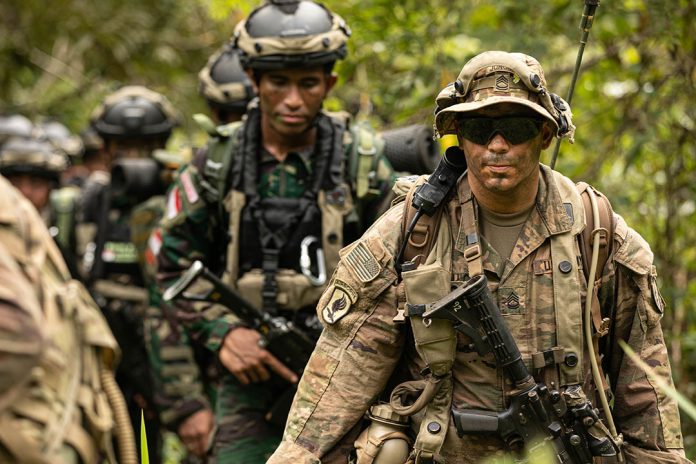Recent US military exercises in Southeast Asia during the first half of 2025 indicate a change in Washington’s approach to regional security under President Donald Trump’s second term.
Shift in military tactics and presence
The administration continues to prioritise competition with China in the Indo-Pacific but uses different methods compared to Trump’s first term. At the 22nd Shangri-La Dialogue, officials outlined a new force-building strategy that focuses more on real-world conditions and clear deterrence goals.
The exercises have deployed long-range tactical systems such as HIMARS, the Navy-Marine Corps Expeditionary Ship Interdiction System (NMESIS), and the Typhon missile system. Training also included amphibious operations and island control, targeting potential conflict zones more directly.
This approach points to the possible establishment of US military outposts on islands near the South China Sea. These outposts would serve two purposes: showing support for regional allies and testing readiness for potential conflicts. For example, the Balikatan 2025 exercise with the Philippines was the largest yet. Unlike the 2017 Balikatan, which focused on humanitarian aid and logistics, this one featured live-fire drills and included partners from outside the region. The shift moves from “risk avoidance” to “deterrence,” reflecting a more proactive stance by US security officials.
Military exercises in Southeast Asia under Trump 2.0 now serve as strategic tools to rebalance the Indo-Pacific military landscape. This marks a clear change from earlier policies, emphasising actual capability over traditional alliance models.
Emerging features of Indo-Pacific strategy 2.0
US Defence Secretary Pete Hegseth, speaking before and during this year’s Shangri-La Dialogue, outlined early elements of the updated Indo-Pacific policy. While the US deals with other global issues, it is expected to release a new Free and Open Indo-Pacific Strategy (FOIP 2.0) in 2026.
The new strategy keeps the principle of “Peace Through Strength” but moves away from multilateral arrangements. Instead, it aims to deepen bilateral defence ties.
A main goal remains to limit China’s growing influence, especially in the South China Sea and the Taiwan Strait. The approach has shifted from symbolic actions like freedom of navigation patrols to building real military strength. Exercises like Balikatan 2025 show readiness for conflict, and training Philippine forces to use the Typhon missile system strengthens deterrence.
The strategy also favours flexible military engagement. Rather than permanent bases, the US plans rotational deployments at key locations. This approach reduces costs and political tensions while maintaining rapid response ability. Programmes such as the Combat Casualty Care Exchange in the Philippines and Tiger Balm 2025 in Singapore show how the US applies this flexibility.
Flexible partnerships and technology transfers
FOIP 2.0 avoids rigid alliances. It encourages partnerships based on specific areas of cooperation, allowing flexible commitment levels. This lets the US adjust to each partner’s political and security needs without the constraints of formal treaties.
The US is expanding defence training and technology transfers through Foreign Military Sales (FMS) and the Excess Defense Articles (EDA) programme. These efforts boost partners’ defence capabilities and create long-term strategic ties through shared technology. Economic tools, including trade measures or tariffs, may also encourage regional countries to align with US interests.
Overall, the Trump 2.0 administration is tailoring its Indo-Pacific policy to current regional realities. It focuses on military strength and rapid response to deter any attempts by China to alter the regional balance by force. This evolving strategy prioritises presence, flexibility, and readiness, potentially redefining the US role in the Indo-Pacific for the years ahead.
